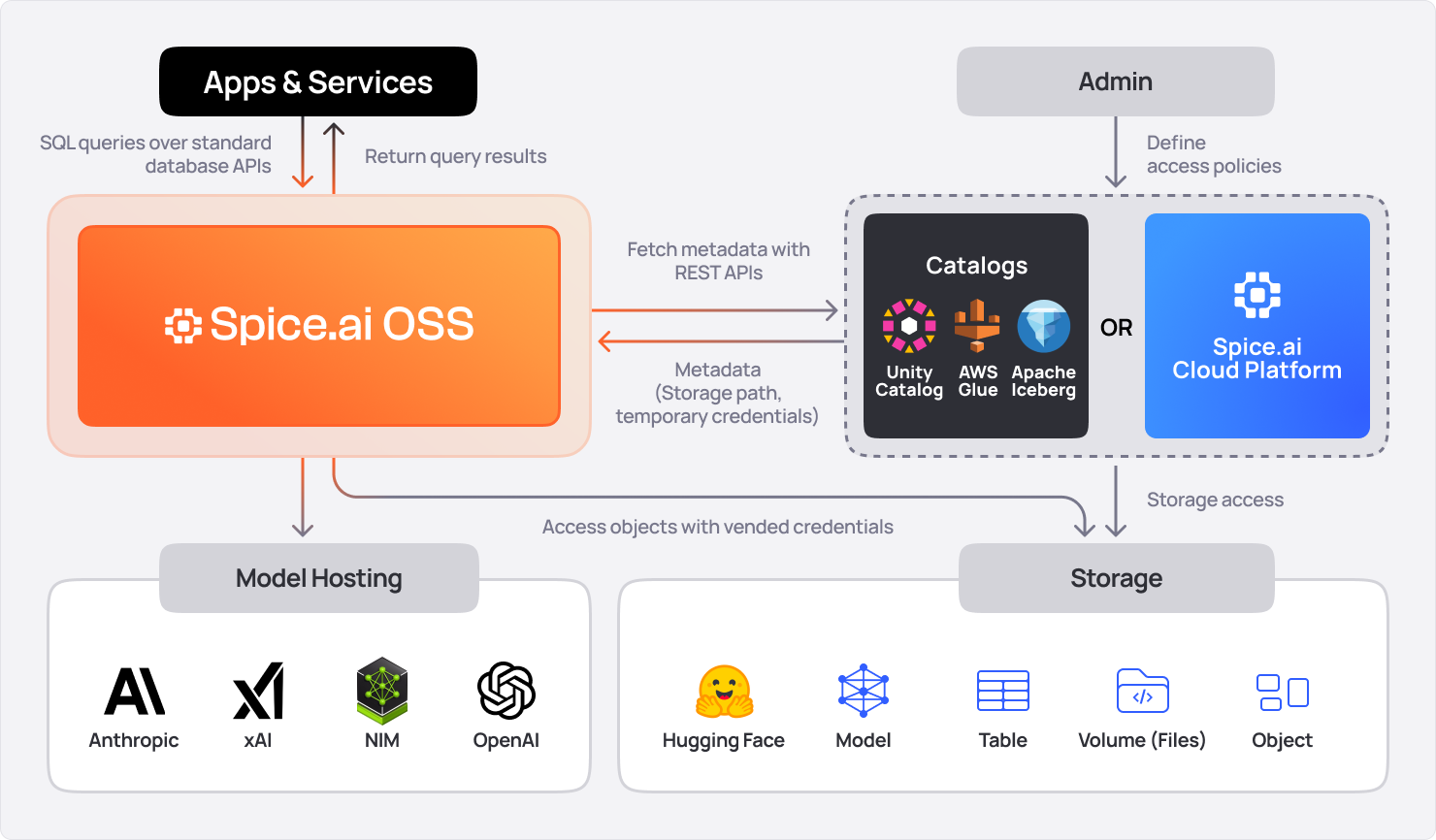
Overview

Architecture

Architecture

Product video
Spice.ai Enterprise is a portable (<150MB) compute engine built in Rust for data-intensive and intelligent applications. It accelerates SQL queries across databases, data warehouses, and data lakes using Apache Arrow, DataFusion, DuckDB, or SQLite. Integrated and co-deployed with data-intensive applications, Spice materializes and accelerates data from object storage, ensuring sub-second query performance and resilient AI applications. Deployable as a container on AWS ECS, EKS, or hybrid cloud & edge, it includes enterprise licensing, support, and SLAs.
Note: Spice.ai Enterprise requires an existing commercial license. For details, please contact sales@spice.ai .
Highlights
- Unified data query and AI engine accelerating SQL queries across databases, data warehouses, and data lakes. Delivers sub-second query performance while grounding mission-critical AI applications with real-time context to minimize errors and hallucinations.
- Advanced AI and retrieval tools, featuring vector and hybrid search, text-to-SQL, and LLM memory, enabling data-grounded AI applications with more than 25 data connectors enabling federated queries and real-time applications.
- Deployable as a container on AWS ECS, EKS, or on-premises, with dedicated support and SLAs for scalable, secure integration into any architecture.
Details
Introducing multi-product solutions
You can now purchase comprehensive solutions tailored to use cases and industries.

Features and programs
Financing for AWS Marketplace purchases

Quick Launch
Pricing
Vendor refund policy
Refunds for Spice.ai Enterprise container subscriptions are not available after activation, as usage begins immediately upon deployment. Ensure compatibility with AWS ECS, EKS, or on-premises setups before purchase. For billing inquiries, contact AWS Marketplace support or Spice AI directly at support@spice.ai .
How can we make this page better?

Legal
Vendor terms and conditions
Content disclaimer
Delivery details
Container Deployment
- Amazon ECS
- Amazon EKS
- Amazon ECS Anywhere
- Amazon EKS Anywhere
Container image
Containers are lightweight, portable execution environments that wrap server application software in a filesystem that includes everything it needs to run. Container applications run on supported container runtimes and orchestration services, such as Amazon Elastic Container Service (Amazon ECS) or Amazon Elastic Kubernetes Service (Amazon EKS). Both eliminate the need for you to install and operate your own container orchestration software by managing and scheduling containers on a scalable cluster of virtual machines.
Version release notes
Spice v1.10.3-enterprise (Dec 29, 2025)
v1.10.3-enterprise is a patch release with improved startup reliability, fixes for Azure BlobFS versioned containers, S3 custom endpoint query resolution, and a fix for the OpenAI Responses API.
What's New in v1.10.3-enterprise
Additional Improvements & Bug Fixes
- Reliability: Telemetry exporter initialization now runs asynchronously, preventing blocked startup in environments with network restrictions (e.g., Kubernetes with restrictive network policies).
- Reliability: Fixed an issue where queries on Azure Blob containers with versioning enabled would fail with "Azure does not support suffix range requests" error in distributed query mode.
- Reliability: Fixed S3 location-based queries against custom S3 endpoints (e.g., MinIO, LocalStack). Queries with location predicates on datasets using s3_endpoint and s3_region parameters now correctly route to the configured endpoint instead of defaulting to AWS S3.
- Reliability: Fixed "project index out of bounds" errors in the query optimizer when union children have mismatched schemas. The optimizer now validates schema compatibility before applying projection pushdown.
- Reliability: Fixed an issue where the OpenAI Responses API (/v1/responses) was not working correctly.
Contributors
Breaking Changes
No breaking changes.
Cookbook Updates
No major cookbook updates.
The Spice Cookbook includes 84 recipes to help you get started with Spice quickly and easily.
Upgrading
To upgrade to v1.10.3, use one of the following methods:
CLI:
spice upgradeHomebrew:
brew upgrade spiceai/spiceai/spiceDocker:
Pull the spiceai/spiceai:1.10.3 image:
docker pull spiceai/spiceai:1.10.3For available tags, see DockerHub .
Helm:
helm repo update helm upgrade spiceai spiceai/spiceaiAdditional details
Usage instructions
Prerequisites
Ensure the following tools and resources are ready before starting:
- Docker: Install from https://docs.docker.com/get-docker/ .
- AWS CLI: Install from https://docs.aws.amazon.com/cli/latest/userguide/getting-started-install.html .
- AWS ECR Access: Authenticate to the AWS Marketplace registry: aws ecr get-login-password --region us-east-1 | docker login --username AWS --password-stdin 709825985650.dkr.ecr.us-east-1.amazonaws.com
- Spicepod Configuration: Prepare a spicepod.yaml file in your working directory. A spicepod is a YAML manifest file that configures which components (i.e. datasets) are loaded. Refer to https://spiceai.org/docs/getting-started/spicepods for details.
- AWS ECS Prerequisites (for ECS deployment): An ECS cluster (Fargate or EC2) configured in your AWS account. An IAM role for ECS task execution (e.g., ecsTaskExecutionRole) with permissions for ECR, CloudWatch, and other required services. A VPC with subnets and a security group allowing inbound traffic on ports 8090 (HTTP) and 50051 (Flight).
Running the Container
- Ensure the spicepod.yaml is in the current directory (e.g., ./spicepod.yaml).
- Launch the container, mounting the current directory to /app and exposing HTTP and Flight endpoints externally:
docker run --name spiceai-enterprise
-v $(pwd):/app
-p 50051:50051
-p 8090:8090
709825985650.dkr.ecr.us-east-1.amazonaws.com/spice-ai/spiceai-enterprise-byol:1.10.3-enterprise-models
--http 0.0.0.0:8090
--flight 0.0.0.0:50051
- The -v $(pwd):/app mounts the current directory to /app, where spicepod.yaml is expected.
- The --http and --flight flags set endpoints to listen on 0.0.0.0, allowing external access (default is 127.0.0.1).
- Ports 8090 (HTTP) and 50051 (Flight) are mapped for external access.
Verify and Monitor the Container
- Confirm the container is running:
docker ps
Look for spiceai-enterprise with a STATUS of Up.
- Inspect logs for troubleshooting:
docker logs spiceai-enterprise
Deploying to AWS ECS Create an ECS Task Definition and use this value for the image: 709825985650.dkr.ecr.us-east-1.amazonaws.com/spice-ai/spiceai-enterprise-byol:1.10.3-enterprise-models. Configure the port mappings for the HTTP and Flight ports (i.e. 8090 and 50051).
Override the command to expose the HTTP and Flight ports publically and link to the Spicepod configuration hosted on S3:
"command": [ "--http", "0.0.0.0:8090", "--flight", "0.0.0.0:50051", "s3://your_bucket/path/to/spicepod.yaml" ]
Register the task definition in your AWS account, i.e. aws ecs register-task-definition --cli-input-json file://spiceai-task-definition.json --region us-east-1
Then run the task as you normally would in ECS.
Resources
Vendor resources
Support
Vendor support
Spice.ai Enterprise includes 24/7 dedicated support with a dedicated Slack/Team channel, priority email and ticketing, ensuring critical issues are addressed per the Enterprise SLA.
Detailed enterprise support information is available in the Support Policy & SLA document provided at onboarding.
For general support, please email support@spice.ai .
AWS infrastructure support
AWS Support is a one-on-one, fast-response support channel that is staffed 24x7x365 with experienced and technical support engineers. The service helps customers of all sizes and technical abilities to successfully utilize the products and features provided by Amazon Web Services.
Similar products


